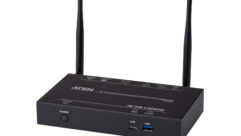
Equipment Security for Classroom Technology
Jan 21, 2009 12:00 PM,
By Linda Seid Frembes

It is an unfortunate fact that theft of AV equipment is a constant concern, especially for schools that have installed integrated classroom AV systems. Equipment that must be in plain view to operate—such as projectors, flatpanel displays, and loudspeakers—are often targeted as high-theft items. “As we are putting in more smart rooms, security issues have become even more important. As the number of installations increases, unfortunately, so does the potential and opportunity for loss.” says Michael Field, senior technical support specialist at Temple University in Philadelphia. “Sometimes small items are taken by accident and the person will bring the equipment back once they realize they took it by mistake.”
Temple University takes a tiered approach to their classroom equipment security—from visible deterrents such as cables and locks to less visible security such as a contact closure wired to a silent alarm that alerts staff and campus police, and regular monitoring by Classroom Technology Staff with AMX‘s Resource Management Suite classroom manager. “There are also staff members who make regular rounds in each area,” Field says.
Because some rooms don’t have installed equipment, portable carts are still in use at Temple. Portable equipment on a cart is tied down with cables and locks at all times, and it is a priority for staff members to be there to collect the cart once the class is over. Field says that cart usage decreases each year because each revision of Temple’s five-year plan includes more smart classrooms.
Equipment security is a constant concern for Malcolm Montgomery, president of EduTech Consulting Services in Cincinnati. As an educational technology consultant, he includes equipment security in all of his smart-classroom designs. During his 28 years at the University of Cincinnati (he retired in 2006), he saw a rise in theft as the university installed more fixed equipment in the classroom.
“Some schools have less of an issue with theft, like my current client that is a seminary graduate school in a remote area,” Montgomery says. “The other end of the spectrum is an open campus in a city setting. The bigger problem is professional thieves who hit the school and take lots of equipment at one time. We had installed 15 remodeled classrooms at the University, and thieves came and took seven to eight projectors over the next holiday weekend.”
Montgomery adds that the best approach to the problem of theft is two-fold: make the equipment hard to steal, and make the equipment less attractive and therefore less profitable to the thief. “Projectors are high-theft items because they are small and light,” he says. “They need to be physically secured via steel aircraft cable to a permanent part of the building. Almost all projectors have a Kensington slot where the cable slides through it. You can also invest in projector mounts that have security screws, but most have heads that fit tools you can buy at any AV shop. To slow down thieves, you can use a variety of head types in the same hang.”
1
Equipment Security for Classroom Technology
Jan 21, 2009 12:00 PM,
By Linda Seid Frembes

AMX Resource Management Suite (RMS)
At Temple, Field uses security cables and padlocks that are openly visible on equipment that would be most at risk. The university also deploys a wider strategy using motion-sensitive room alarms, projectors wired directly to a silent alarm via a contact closure, and fixed alarm panels that have an audible alarm that also sends a message to staff and campus police. “There are one to two full-time staff as well as student workers to cover each area,” Field says. “There is enough staff to notice if someone they don’t recognize is moving equipment out of a classroom.”
The second part of the approach is to alter the appearance of the equipment or, as Montgomery describes, to “uglify it” using decals, paint, a soldering iron, or a branding iron. “You must make the alteration visible so the thief will see it and may get deterred,” says Montgomery, who used to paint a series of stripes on his equipment.
Field adds that laptops at Temple have specialized tracking software and an ID tag that includes a solvent in the glue that burns the tag information into the laptop if it’s removed. Additionally, the AV systems at Temple are monitored through AMX’s Resource Management Suite (RMS) for realtime monitoring. “If a piece of equipment shows as offline, a staff member is notified by email and text alert to go check it out,” Field says.
Overall, Montgomery cautions that a professional thief can get in and out of a classroom in 2 minutes to 3 minutes—a window of time so small that staff may not have enough time to respond. “Therefore, try to design the system so that the security device trips early in the removal process,” he says.
The staff at Temple is also more vigilant with their rounds during semester breaks, finals, holidays, and other quiet times when there are less people on campus. Staff members are instructed to stop and question anyone moving equipment whom they don’t recognize.
Finally, if all efforts fail and theft does occur, schools need to report every theft to the local police, as well as notify local AV vendors and the manufacturer, and check online auction sites for their stolen equipment. In some cases, according to Montgomery, the mere act of reporting a theft may result in the equipment mysteriously reappearing.

An Equipment Safety Checklist
According to Malcolm Montgomery, president of Edutech Consulting Services in Cincinnati, there are some protective measures that schools can take to deter theft of AV equipment:
- Visible warning labels that may overstate the security systems in effect
- Physical deterrents such as padlock and chains
- Projector security mounts
- Projector security cages that are locked and/or alarmed
- Start-up screens with institution ID
- Start-up access codes
- Screamer alarms bonded to equipment
- Security cameras
- Tamper sensors connected to the alarm system
- Smart control systems (or projector remote management software) as an alternative or adjunct to a central alarm system
- Security screws
- Branding iron with institution ID that cannot be removed or covered by an added label.
2










